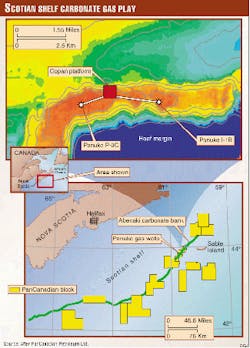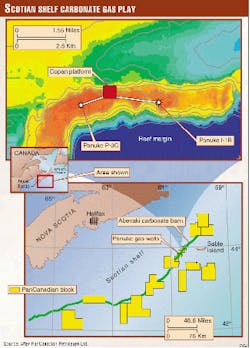Basins on and off Canada's east coast number among the world's most-watched exploration areas.
The region has unexplored and underexplored basins, land and offshore drilling, drilling moratoria, boundary disputes, icebergs in some areas, and more.
Most of the discovered resource on the Scotian shelf has been gas in the Upper Jurassic Mic Mac formation and the Cretaceous Logan Canyon, Missisauga, Dawson Canyon, and Wyandot formations. Oil has been found mainly in the Logan Canyon and Missisauga formations.
Now two wells drilled by PanCanadian Petroleum Ltd., Calgary, seem to be launching a Jurassic reef play that could extend for a great distance.
Panuke gas reservoir
PanCanadian's P-3C and I-1B wells each flowed 52-55 MMcfd of gas, maximum capacity of test equipment. PanCanadian's working interest is 100%.
P-3C intersected 230 ft of net pay in the Jurassic Abenaki limestone reef formation in April 1999. TD is 4,163 m. I-1B cut 100 ft of pay in the same formation. Its TD is 4,046 m.
The two wells, drilled from Panuke platform, have TDs about 4 km apart. The wells lie along an Abenaki-Iroquois carbonate reef bank. The reef bank is believed to extend almost the length of the Nova Scotia peninsula.
The Abenaki formation is divided into, from bottom to top, the lower carbonate Scatarie member, a middle shale Misaine member, and an upper predominantly carbonate Baccaro member.
Baccaro, the thickest member, is known to reach thicknesses of 1,000 ft. PanCanadian's wells are believed to have tested gas from Baccaro.
The Uniacke G-72 well, drilled in 1984 to 18,815 ft about 25 miles northeast of Panuke and north of the eastern end of Sable Island, flowed 20 MMcfd of gas and 151 b/d of condensate from the Misaine member of Abenaki.
PanCanadian's two wells, bottomed west and east of the Panuke field oil platform, are less than 25 miles from the producing platform at Thebaud gas field, part of the Sable Offshore Energy Project (SOEP). However, PanCanadian said its gas tests at Panuke "signal the potential emergence of another East Coast natural gas project."
Operators of Scotian shelf fields floated numerous pipeline proposals during the 1980s and early 1990s, but only SOEP has been built.
SOEP began transporting gas in the last days of 1999. Flow, ramping up past 200 MMcfd in early March, is to exceed 500 MMcfd by yearend 2000 with completion of laterals to Halifax, N.S., and Saint John, N.B. (see maps, OGJ, Oct. 19, 1998, p. 25).
Reserves in six fields dedicated to SOEP total more than 3 tcf of gas plus about 100 million bbl of natural gas liquids. Development drilling is in full swing at Thebaud, North Triumph, and Venture fields. Alma, Glenelg, and South Venture fields are to be developed in 2004-2007.
Mobil Oil Canada Ltd. has said that more than 2 tcf of additional gas has been identified at about 11 Sable satellite fields which, if eventually tied in, could significantly extend the initial 25-year project life. This figure does not include Panuke gas. Geological Survey of Canada estimates Scotian shelf gas reserve potential at 18 tcf.
Panuke's gas future
PanCanadian's two-well, deeper-pay gas discovery under Panuke oil field west of Sable Island represents a new chapter for the field.
PanCanadian did not specify a development timetable for the Panuke gas. The company said it would continue evaluation of the discovery to determine reserve size and commercial potential with the drilling of at least two Scotian shelf wells this year.
The company holds 15 blocks off Nova Scotia that cover more than 4 million gross acres (more than 2.5 million net acres). Several of the blocks overlap the carbonate reef bank.
PanCanadian acquired Nova Scotia Resources Ltd.'s (NSRL) interest in the deep zones covered by Production License 2902 below Panuke field, effective Oct. 1, 1999. NSRL retained an overriding royalty.
Panuke and nearby Cohasset fields, discovered in 1986 and 1973, respectively, produced oil for the first time in 1992 and for the last time in December 1999. No oil pipeliline was built. Lasmo Nova Scotia Ltd. and NSRL recovered 44 million bbl out of original oil in place estimated at 98 million bbl.
The project, 155 miles southeast of Halifax in an ice-free area on the western edge of the Sable sub-basin, was known as Copan.
Jack-ups have drilled most wells on the Scotian shelf, where water is 600 ft deep or less. Water is about 150 ft deep at Panuke.
Considered depleted now, the two fields produced high-gravity oil from the Missisauga formation. Cohasset also produced from Logan Canyon. Oil producing depths were 2,300-2,500 m. Fluid analysis showed the hydrocarbon proved to be a light oil with condensate properties (OGJ, May 6, 1991, p. 64).
PanCanadian, successor to Lasmo, later used a directional well from the Copan platform to tie in Balmoral, a 1991 discovery about 2 miles northeast of Copan. It flowed a combined 9,495 b/d of oil from three zones.



